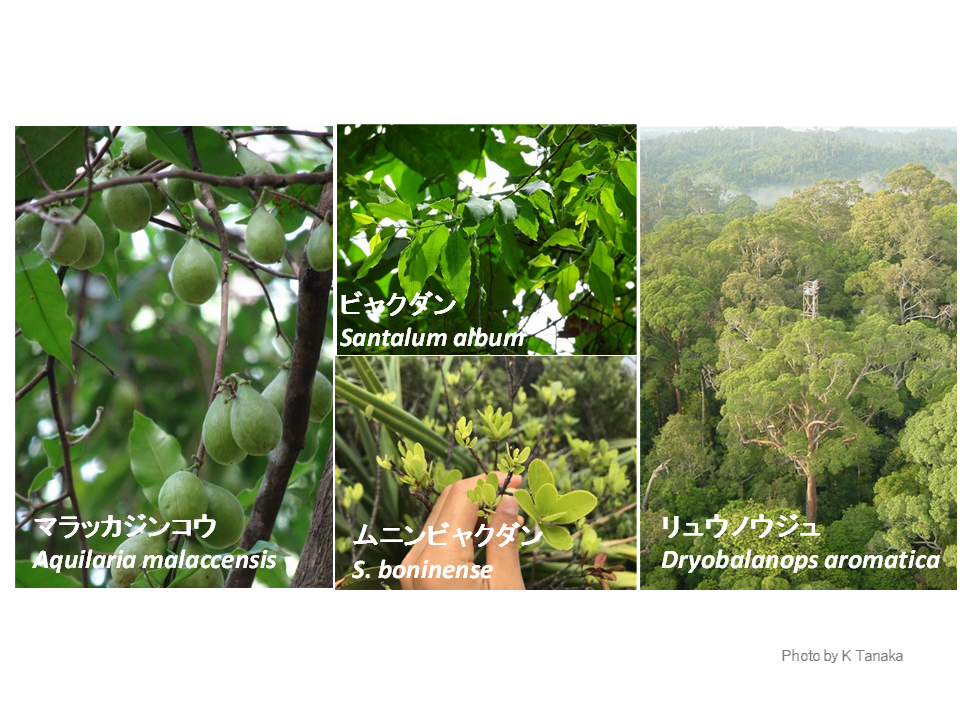Pick Up
1001. Scents from Tropical Forests

1001. Scents from Tropical Forests
Plant scents are all around us. Many of the scents used in aromatherapy, especially for healing the tired mind and body, are derived from tropical forest plants. You may not know the names agarwood, sandalwood, and borneol, but you may have encountered their scents. In fact, only a few people have never smelled their scents. Tropical forests are an important source of timber resources, but these non-timber forest products also support people's livelihoods and help generate income for sustainable forestry. Here are some scents that come from tropical forests.
First is agarwood, a member of the Thymelaeaceae family (genus Aquilaria). Resin, which is very rarely deposited on the wood of the agarwood tree, emits a unique aroma when burned, making it a raw material for incense, incense sticks, and perfumes. About 20 species of agarwood are known, mainly in Southeast Asia. It has been highly prized since ancient times, and even in Japan, a huge piece of agarwood called "Ranjatai" (156 cm long) is stored in the Shosoin Repository in Japan that developed in the 8th century. The highest quality agarwood is called Kyara, and is sometimes sold for tens of thousands of yen or more per gram. The amount of agarwood resources has been decreasing drastically due to continued overharvesting and theft of agarwood from protected areas. For this reason, efforts are being made to produce agarwood, by planting agarwood trees and artificially depositing resin by scratching the wood or applying fungus, but the quality is inferior to that of natural agarwood.
The next species is sandalwood, also known as Byakudan, which is a member of the family Santalaceae and is found in India, Indonesia, and other tropical countries. More than 20 species are known, of which sandalwood (Santalum album) is the most important. Because the wood itself emits a scent, it is processed to make Buddhist ritual utensils and fan bones, and the essential oil extracted from the wood is used in incense, incense sticks, perfumes, and other products. Mistletoe, which belongs to the same family, is a well-known semi-parasitic plant, and sandalwood also produces parasitic roots that grow on the roots of other plants. In Japan, Munin sandalwood (S. boninense) grows in the wild in Ogasawara Islands, but it has escaped overharvesting because of the weak scent of its wood.
Last is the borneol. Borneol is obtained from a tree called Dryobalanops aromatica, which is a member of the Dipterocarpaceae family that grows in the tropical rainforests of Malaysia and Indonesia. There are nearly 500 known species of this family, which are dominant in the forests of Southeast Asia. The leaves and resin have a clear aroma, and the extracted borneol, also called Ryunou, has been used as a raw material for fragrances, medicines, and fragrance of traditional Japanese ink. Now that it can be chemically synthesized, the number of natural products has decreased and the price has declined, but it was once an important trade item. Interestingly, analysis of DNA contained in the dental tartar of Edo period townspeople found DNA from Dipterocarpaceae trees, which do not grow in Japan. It is written in literature that borneol was mixed as a flavoring agent in toothpaste during the Edo period, scientifically confirming that products of tropical forests were used by the common people of Edo on a daily basis.
Tropical forests are home to the trees that are the source of these fragrances, but they continue to be degraded and deforested due to excessive logging and conversion to plantations. There is a need to properly maintain and manage forest resources appropriately, such as by developing afforestation techniques and calculating appropriate logging volumes, as well as by conducting sustainable forestry.
Eyecatch Photos:
Agarwood fruits (left), sandalwood (upper middle) and munin sandalwood (lower middle), and giant dipterocarp tree (right)
Agarwood, sandalwood, and borneol are collected from wood and resin, and are products of tropical forests. Munin sandalwood is the only one that is naturally distributed in Japan, but it grows only in the Ogasawara Islands.
*Munin sandalwood provided by Dr. Kawai.
Contributor: TANAKA Kenzo (Forestry Division)
--------------------------------------------------------------
JIRCAS Online Science and Technology Week
The week from Monday (April 15) to Sunday (April 21) including "Invention Day" (link in Japanese) on April 18 every year is called "Science and Technology Week" and was established in February 1960 for the purpose of deepening the understanding and interest in science and technology among the general public and promoting science and technology in Japan. Various science and technology-related events are held by science museums, universities, research institutes, and other organizations throughout Japan.
As part of Science and Technology Week starting on Monday, April 15, JIRCAS has opened the Special Site for the JIRCAS Online Science and Technology Week, where mini-lecture videos by researchers are available. If interested, please check out Dr. KAWAI Kiyosada's mini-lecture titled "Knowing trees and creating forests - Challenges in Southeast Asia,'' which introduces the tropical forests of Southeast Asia. The following two newly recorded mini-lecture videos (in Japanese) have also been made available.
KOBAYASHI Shintaro What kind of place is your home, the Asia-Monsoon Region? Characteristics, Challenges, and International Cooperation
KOBORI Yoichi What type of research is required to protect our crops from transboundary insect pests?
We hope that this event will further deepen the relationship between JIRCAS and the general public, disseminate useful research information, and provide an opportunity for the public to understand international agricultural, forestry, and fisheries research.
Special Site for the JIRCAS Online Science and Technology Week
